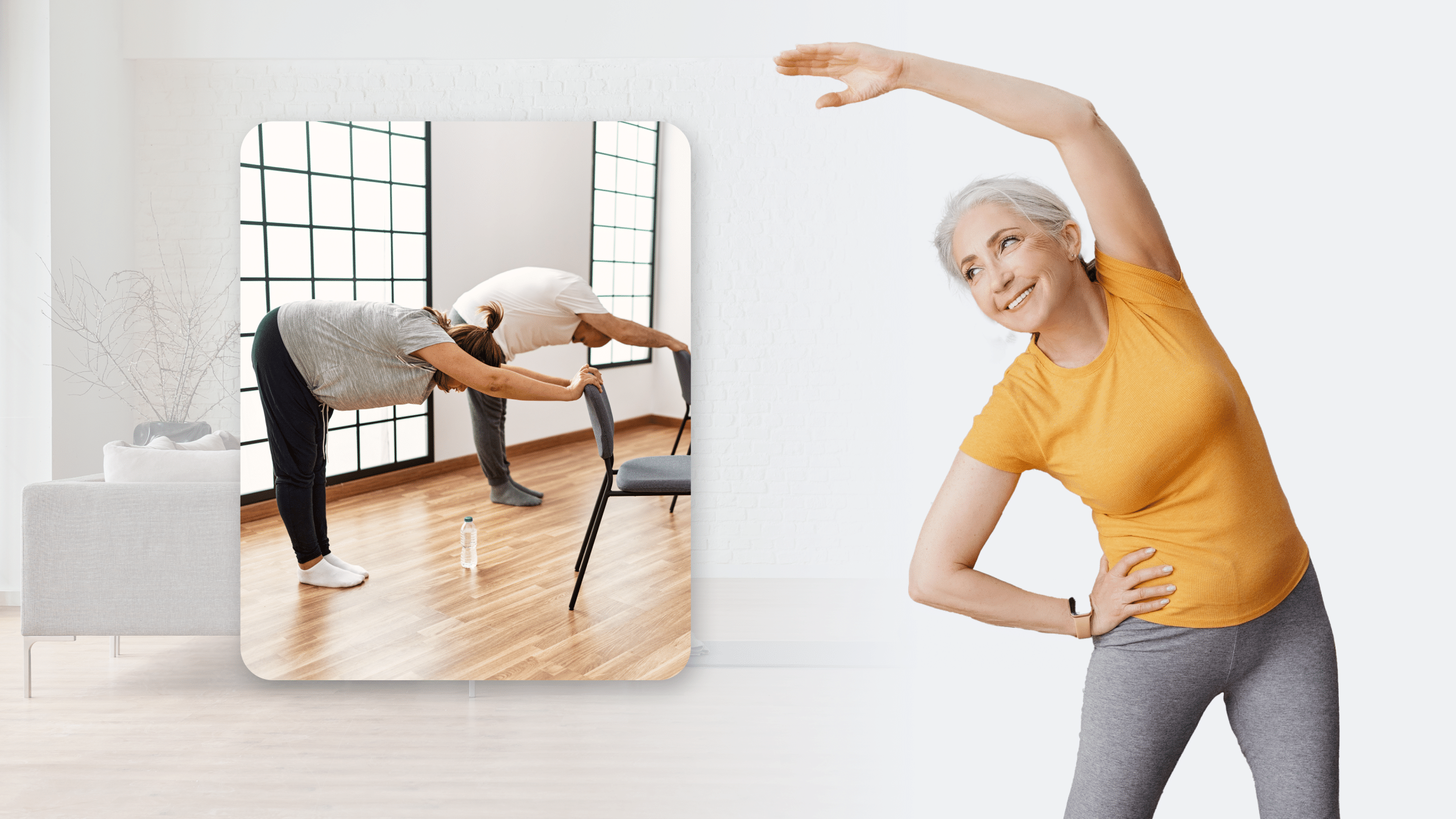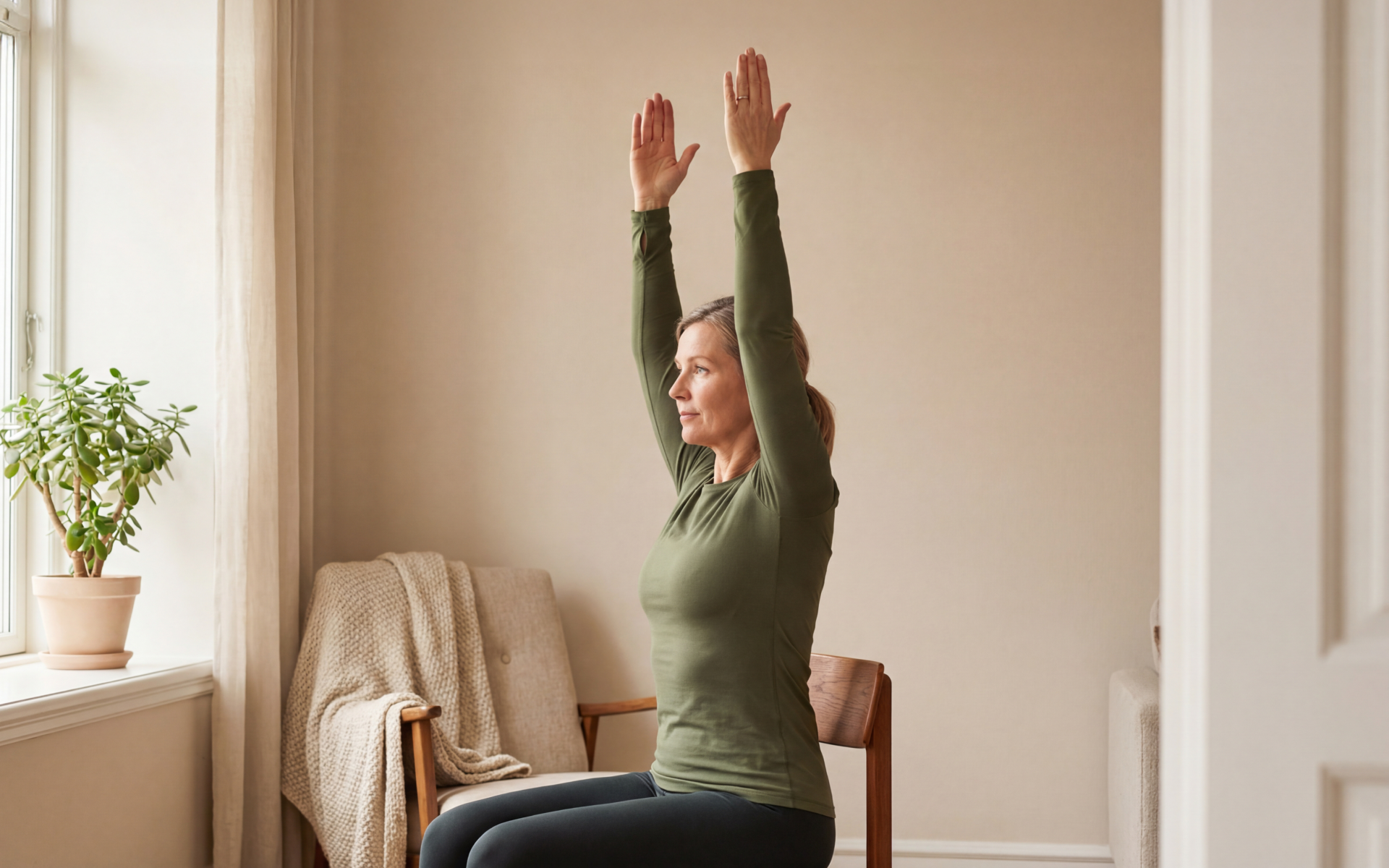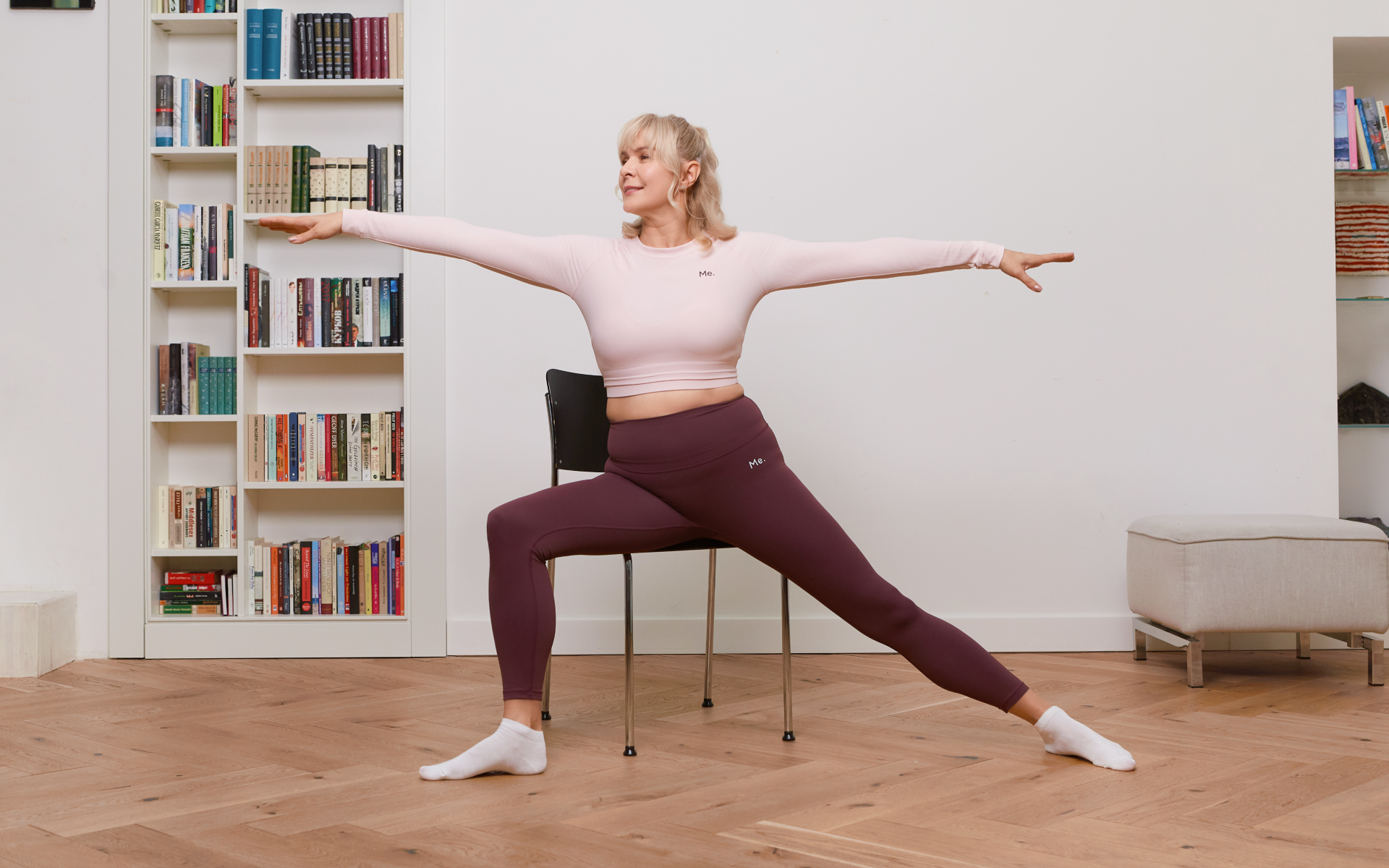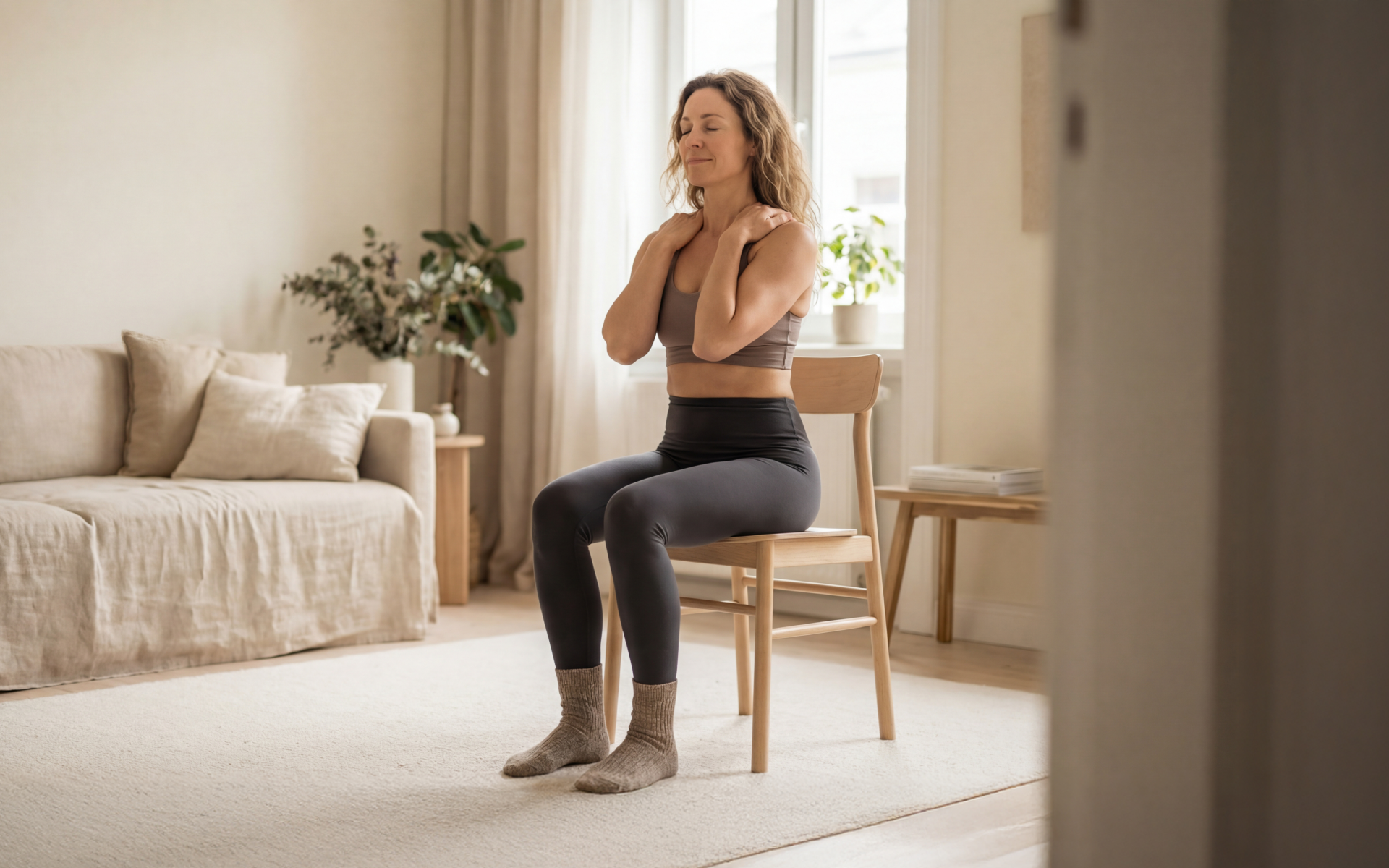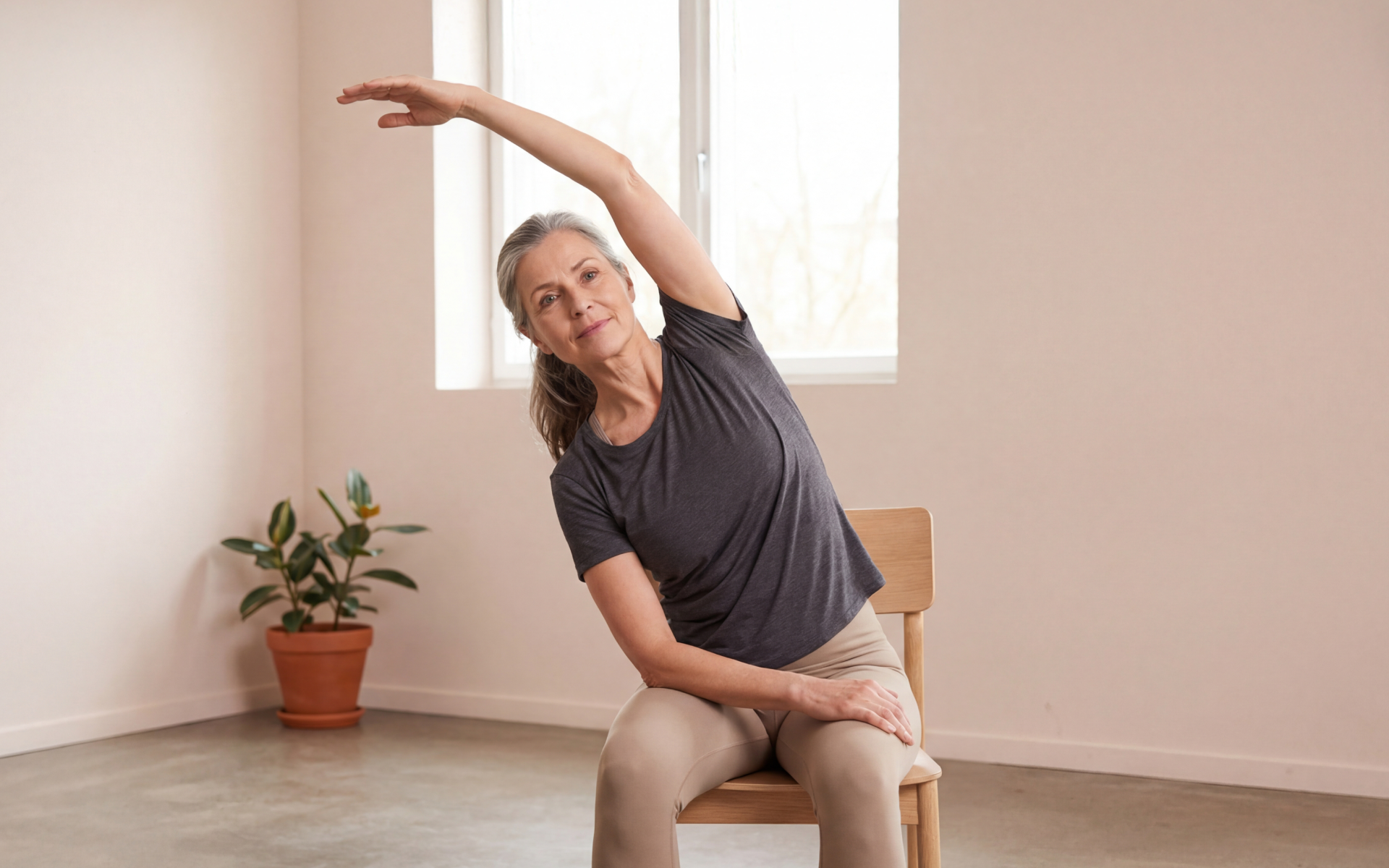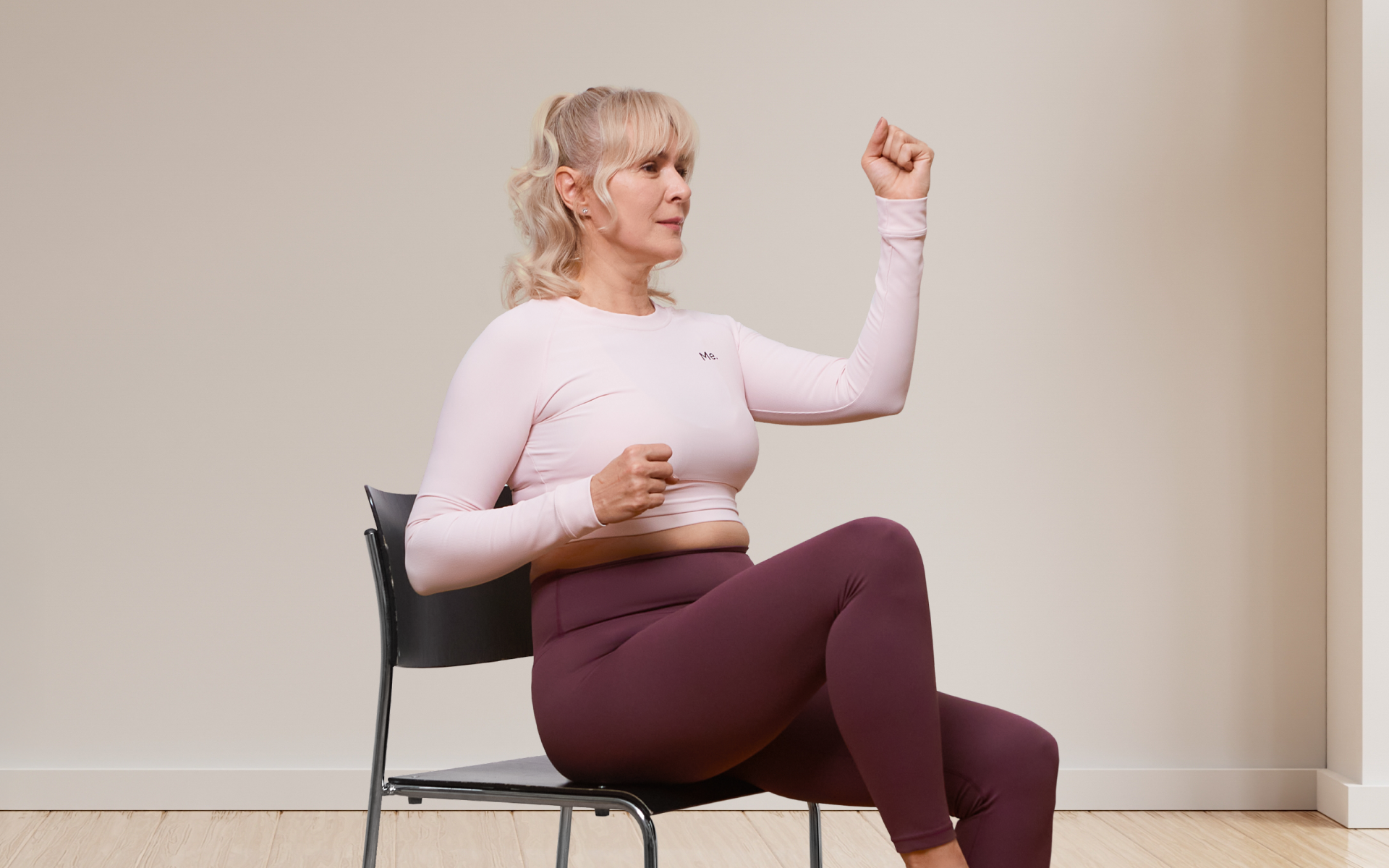Regular exercise can be challenging for seniors who are less mobile or suffering from health conditions. However, chair yoga offers an accessible way to bring gentle movement back into daily life, as well as the additional benefits yoga provides. This article will explore the benefits of chair yoga, how chair yoga can build strength and improve your health, and provide a chair yoga workout plan to get you started.
Benefits of Chair Yoga for Seniors
Chair yoga offers a wide range of physical, mental, and social benefits for seniors:
Physical Benefits:
- It’s an accessible form of movement with low risk of injury
- It can improve circulation for those with limited mobility
- Long-term practice can increase strength and flexibility
- It has a low-impact on joints, which makes it a safe and effective form of exercise for senior practitioners
Mental Benefits:
- Slowing down, stretching gently, and focusing on your breath can reduce stress and anxiety
- It can help improve your mood and mental clarity
- Many seniors are worried about injuries and falls, so increased physical ability leads to increased confidence
Social benefits
- Even when practiced online (4), group chair yoga classes can create a sense of community and peer support for each other’s health and well-being
- An improvement in physical and mental health can make socializing more enjoyable for seniors
How Often Should Seniors Do Chair Yoga?
As with all forms of exercise, to experience the benefits of chair yoga, you need regular and consistent practice. This is generally at least 1-2 times per week. Studies have shown that at least 12 weeks of chair yoga practiced twice weekly can lead to a significant improvement in fitness and reduced fear of falls (2).
As it’s a gentle form of exercise, a daily practice of chair yoga for seniors is safe and effective for healthy individuals. Please follow your doctor’s advice if you suffer from any health conditions.
Betterme will keep you laser-focused on your weight loss journey! Nutrient-packed meal plans, fat-blasting workouts, galvanizing challenges and much more. Try using the app and see for yourself!
Can You Lose Weight Doing Chair Yoga for Seniors?
Chair yoga is a low-impact form of exercise. While all forms of movement will burn some calories, higher intensity exercises are more effective for noticeable weight loss.
For those who struggle with mobility, such as seniors, chair yoga may be a valuable practice to get back into exercising. Once they become more mobile through chair yoga exercises, they may then be able to move on to other forms of exercise that are more focused on weight loss, if that’s their concern.
For seniors who are already in good health, there are chair yoga poses that can be adapted to create a higher-intensity workout that may help with weight loss.
What Type of Yoga Is Best for Seniors?
Due to its accessibility and the low risk of injury, chair yoga is the perfect type of yoga for seniors to practice.
For seniors who are struggling with their health, mobility, and energy levels, it can be difficult to exercise regularly. However, chair yoga for seniors is effective and accessible as it provides many health benefits through seated movement.
In addition, it’s common for seniors to be concerned about injury and falls, which can cause stress and anxiety and make exercising less appealing. However, chair yoga for seniors, provides very low risk for injury and has even proven that it can balance stress hormones (1).
Overall, chair yoga for seniors is high in benefits and low in risks, which makes it a brilliant way to maintain strength, balance, and mobility.
How to Do Chair Yoga for Seniors: 6 Chair Yoga Postures to Start Your Practice
The following chair yoga postures are suitable for people of all abilities, including seniors with limited mobility. These chair yoga poses can be practiced individually or as a daily or weekly sequence.
It’s recommended that you practice these postures under the guidance of a certified yoga teacher and follow the advice of your doctor if you’ve been diagnosed with a health condition or are taking any medication.
1. Seated Mountain Pose
This posture is a great way to start your chair yoga practice. It focuses on stillness and breath, which will calm and steady the mind and prepare the body for gentle movement.
- Sit toward the front of your chair and gently press your feet into the ground as your straighten and lengthen your spine
- Hold your arms by your sides in a low V-shape
- As you’re seated here, you may close your eyes or lower your gaze to the floor if you wish
- Take at least 10 breaths here, as you focus on deep steady breathing while holding the posture
Read more: 21 Day Chair Yoga: Reasons To Add This Challenge To Your Routine
2. Seated Eagle Pose
This version of eagle just focuses on the movement of the arms. It provides a stretch to the upper back and shoulders. It also creates a slight compression to the chest, elbows, and wrists, which when released, encourages fresh blood flow to these areas and boosts circulation.
- Start seated comfortably with a straight spine and your feet on the floor
- Reach both arms out in front of you, then cross your right elbow on top of your left elbow
- Bend your arms and gently pull the elbows down to feel a slight stretch in the upper back and shoulders
- You can hold the posture here, or you may be able to also cross the right wrist in front of the left wrist and interlace your fingers
- Hold for 3 breaths, then release the arms and take a few breaths before repeating on the other side
3. Seated Cat-Cow
Cat-cow is usually practiced on the floor in a tabletop position. However, when it’s performed seated, it can still provide many benefits, including gently increasing flexibility in the spine and neck and encouraging full use of the lungs through the body’s movement with the breath. Ths movement of the spine is believed to be energizing for the body.
- Sit with a straight spine and your feet on the floor, approximately hip-width apart
- Place your hands on your thighs with your arms straight to support your spine
- As you inhale, allow your chest to lift up and forward, press your stomach forward to create a small backward bend, and lift the chin looking up to the ceiling
- As you exhale, tuck your stomach in and lower your chin down toward your chest to curve your spine, gaze towards your navel
- Repeat this for at least 1 minute
4. Seated Spine Twist
A spinal twist has many benefits for the lungs, kidneys, and digestive system. It’s easy and effective to practice while sitting in a chair.
- Sit toward the front of your chair with your feet parallel and pressing gently into the ground
- Reach your arms out to your sides, then bend your elbows and interlace your fingers behind your head
- Gently engage your abdominal muscles and press your left foot into the floor – take an inhale as you turn your body to the right
- As you exhale, bring yourself back to center
- Keep your arms where they are as you inhale and turn your body to the left, and again exhale back to center
- Repeat for 6-8 breaths
BetterMe app will kick you out of the mental funk, shake off your extra weight, rid you off your energy-zapping habits, and help you sculpt the body of your dreams. Intrigued? Hurry up and change your life for the better!
5. Seated Forward Fold
This forward fold will stretch the mid and lower back and support spinal health. This posture is good for circulation, but if you suffer from particularly low blood pressure, you may want to avoid bringing your head down below your knees and seek advice from your doctor.
- Start seated toward the front of your chair and open your feet out to approximately the width of the chair legs
- Bring your hands toward your knees and engage the abdominal muscles as you start to hinge from the hips, bringing your head down between your knees
- If it’s accessible and comfortable for you, you can allow your arms to relax toward the floor and your head to hang between your knees
- Alternatively, if there is more resistance in the spine or you suffer from very low blood pressure, you can keep your hands on your knees to support you and relax your neck so your head is looking toward the floor
- Hold for 5 breaths and then come back up slowly – it’s normal to feel very slightly dizzy and if so, take a few moments to recover before you move on to the next pose
6. Seated Pigeon Pose
While many of the postures above are focused on the spine and the upper body, the seated pigeon pose will activate your hips and pelvis. For seniors, healthy hips are important for keeping mobile as this is an area that can become stiff due to decreased mobility and spending more time seated. Therefore, it can be more challenging. However, over time and through regular practice, you’ll experience the benefits.
- Sit with a straight spine and both feet on the floor
- Lift your right knee up and hold around it with both hands, gently pulling your thigh toward your chest, breathing steadily
- If it’s accessible to you, take hold of your right foot with your left hand
- Allow your right knee to relax to the side as you place your right foot on top of your left knee – you can keep hold of your right knee with your right hand for support
- It’s important not to force any movement here, instead you’re encouraging the hips to relax and soften
- Hold this pose for 5 breaths
- Take care as you come out of the posture and repeat on the other side
Generally, it’s clear that chair yoga provides many benefits for seniors and can be adapted to suit all mobility needs. It’s a safe way to reintroduce movement for those who have experienced health issues or injuries, or who haven’t exercised for a long time.
Read more: Unlocking Relaxation: The Magic of Restorative Chair Yoga
FAQs
How long does it take to see results with chair yoga?
Results will vary from person to person, depending on your age and health status, but generally, people who stick to a consistent yoga practice start to feel the physical and mental benefits in 6-12 weeks (3).
Which is better for seniors, Pilates or chair yoga?
Both have benefits and may suit different people depending on their health and mobility. However, Pilates may not be accessible to all, so chair yoga is a brilliant way for seniors to start an exercise routine as there is very little injury risk.
Does chair yoga count as exercise?
Yes, chair yoga counts as exercise, although it’s a less strenuous form of movement. This makes it the perfect form of exercise for those who are suffering from health conditions or reduced mobility, such as seniors. It’s also possible to adapt some chair yoga poses to make them more challenging for those who are in good health or who have practiced chair yoga for a while and want to increase their endurance.
DISCLAIMER:
This article is intended for general informational purposes only and does not serve to address individual circumstances. It is not a substitute for professional advice or help and should not be relied on for making any kind of decision-making. Any action taken as a direct or indirect result of the information in this article is entirely at your own risk and is your sole responsibility.
BetterMe, its content staff, and its medical advisors accept no responsibility for inaccuracies, errors, misstatements, inconsistencies, or omissions and specifically disclaim any liability, loss or risk, personal, professional or otherwise, which may be incurred as a consequence, directly or indirectly, of the use and/or application of any content.
You should always seek the advice of your physician or other qualified health provider with any questions you may have regarding a medical condition or your specific situation. Never disregard professional medical advice or delay seeking it because of BetterMe content. If you suspect or think you may have a medical emergency, call your doctor.
SOURCES:
- Effects of a chair-yoga exercises on stress hormone levels, daily life activities, falls and physical fitness in institutionalized older adults (2016, ScienceDirect.)
- Effects of chair yoga therapy on physical fitness in patients with psychiatric disorders: A 12-week single-blind randomized controlled trial (2017, ScienceDirect.)
- How Quickly Can Yoga Change Your Body? (2022, MedicineNet.)
- Online Chair Yoga and Digital Learning for Rural Underserved Older Adults at Risk for Alzheimer’s Disease and Related Dementias (2024, PubMed.)
